High-Quality AlN Grown on Si(111) Substrate by Epitaxial Lateral Overgrowth
Abstract
:1. Introduction
2. Materials and Methods
3. Results and Discussion
4. Conclusions
Author Contributions
Funding
Data Availability Statement
Acknowledgments
Conflicts of Interest
References
- Kneissl, M.; Seong, T.-Y.; Han, J.; Amano, H. The emergence and prospects of deep-ultraviolet light-emitting diode technologies. Nat. Photonics 2019, 13, 233. [Google Scholar] [CrossRef]
- Liu, Y.; Cai, Y.; Zhang, Y.; Tovstopyat, A.; Liu, S.; Sun, C. Materials, Design, and Characteristics of Bulk Acoustic Wave Resonator: A Review. Micromachines 2020, 11, 630. [Google Scholar] [CrossRef] [PubMed]
- Dai, Y.; Li, S.; Sun, Q.; Peng, Q.; Gui, C.; Zhou, Y.; Liu, S. Properties of AlN film grown on Si(111). J. Cryst. Growth 2016, 435, 76. [Google Scholar] [CrossRef]
- Zhao, W.; Asadi, M.J.; Li, L.; Chaudhuri, R.; Nomoto, K.; Xing, H.G.; Hwang, J.C.M.; Jena, D. X-band epi-BAW resonators. J. Appl. Phys. 2022, 132, 024503. [Google Scholar] [CrossRef]
- Zhang, Y.; Long, H.; Zhang, J.; Tan, B.; Chen, Q.; Zhang, S.; Shan, M.; Zheng, Z.; Dai, J.; Chen, C. Fast growth of high quality AlN films on sapphire using a dislocation filtering layer for ultraviolet light-emitting diodes. Crystengcomm 2019, 21, 4072. [Google Scholar] [CrossRef]
- Ezubchenko, I.S.; Chernykh, M.Y.; Mayboroda, I.O.; Trun’kin, I.N.; Chernykh, I.A.; Zanaveskin, M.L. High-Quality AlN Layers Grown on Si(111) Substrates by Metalorganic Chemical Vapor Deposition. Crystallogr. Rep. 2020, 65, 122. [Google Scholar] [CrossRef]
- Huang, L.; Li, Y.; Wang, W.; Li, X.; Zheng, Y.; Wang, H.; Zhang, Z.; Li, G. Growth of high-quality AlN epitaxial film by optimizing the Si substrate surface. Appl. Surf. Sci. 2018, 435, 163. [Google Scholar] [CrossRef]
- Tao, T.; Zhang, R.; Zhi, T.; Liu, B.; Lei, J.; Dai, J.; Xie, Z.; Zhou, Y.; Chen, D.; Lu, H. Observation and Modeling of Leakage Current in AlGaN Ultraviolet Light Emitting Diodes. IEEE Photonics Technol. Lett. 2019, 31, 1697. [Google Scholar] [CrossRef]
- Huang, Y.; Liu, J.; Sun, X.; Zhan, X.; Sun, Q.; Gao, H.; Feng, M.; Zhou, Y.; Ikeda, M.; Yang, H. Crack-free high quality 2 μm-thick Al0.5Ga0.5N grown on a Si substrate with a superlattice transition layer. Crystengcomm 2020, 22, 1160. [Google Scholar] [CrossRef]
- Li, Z.; Liu, L.; Huang, Y.; Sun, Q.; Feng, M.; Zhou, Y.; Zhao, H.; Yang, H. High-power AlGaN-based near-ultraviolet light-emitting diodes grown on Si(111). Appl. Phys. Express 2017, 10, 072101. [Google Scholar] [CrossRef]
- SaifAddin, B.K.; Almogbel, A.; Zollner, C.J.; Foronda, H.; Alyamani, A.; Albadri, A.; Iza, M.; Nakamura, S.; DenBaars, S.P.; Speck, J.S. Fabrication technology for high light-extraction ultraviolet thin-film flip-chip (UV TFFC) LEDs grown on SiC. Semicond. Sci. Technol. 2019, 34, 035007. [Google Scholar] [CrossRef]
- Takeuchi, M.; Maegawa, T.; Shimizu, H.; Ooishi, S.; Ohtsuka, T.; Aoyagi, Y. AlN/AlGaN short-period superlattice sacrificial layers in laser lift-off for vertical-type AlGaN-based deep ultraviolet light emitting diodes. Appl. Phys. Lett. 2009, 94, 061117. [Google Scholar] [CrossRef]
- Cho, H.K.; Krüger, O.; Külberg, A.; Rass, J.; Zeimer, U.; Kolbe, T.; Knauer, A.; Einfeldt, S.; Weyers, M.; Kneissl, M. Chip design for thin-film deep ultraviolet LEDs fabricated by laser lift-off of the sapphire substrate. Semicond. Sci. Technol. 2017, 32, 12LT01. [Google Scholar] [CrossRef]
- Sun, Y.; Zhou, K.; Feng, M.; Li, Z.; Zhou, Y.; Sun, Q.; Liu, J.; Zhang, L.; Li, D.; Sun, X.; et al. Room-temperature continuous-wave electrically pumped InGaN/GaN quantum well blue laser diode directly grown on Si. Light Sci. Appl. 2018, 7, 13. [Google Scholar] [CrossRef] [Green Version]
- Feng, M.; Wang, J.; Zhou, R.; Sun, Q.; Gao, H.; Zhou, Y.; Liu, J.; Huang, Y.; Zhang, S.; Ikeda, M.; et al. On-Chip Integration of GaN-Based Laser, Modulator, and Photodetector Grown on Si. IEEE J. Sel. Top. Quantum Electron. 2018, 24, 1. [Google Scholar] [CrossRef]
- Liu, J.; Huang, Y.; Sun, X.; Zhan, X.; Sun, Q.; Gao, H.; Feng, M.; Zhou, Y.; Ikeda, M.; Yang, H. Wafer-scale crack-free 10 µm-thick GaN with a dislocation density of 5.8 × 107 cm−2 grown on Si. J. Phys. D 2019, 52, 425102. [Google Scholar] [CrossRef]
- Sun, Q.; Yan, W.; Feng, M.; Li, Z.; Feng, B.; Zhao, H.; Yang, H. GaN-on-Si blue/white LEDs: Epitaxy, chip, and package. J. Semicond. 2016, 37, 044006. [Google Scholar] [CrossRef]
- Sun, Y.; Zhou, K.; Sun, Q.; Liu, J.; Feng, M.; Li, Z.; Zhou, Y.; Zhang, L.; Li, D.; Zhang, S.; et al. Room-temperature continuous-wave electrically injected InGaN-based laser directly grown on Si. Nat. Photonics 2016, 10, 595. [Google Scholar] [CrossRef]
- Zhang, Z.-Z.; Yang, J.; Zhao, D.-G.; Liang, F.; Chen, P.; Liu, Z.-S. Influence of the lattice parameter of the AlN buffer layer on the stress state of GaN film grown on (111) Si. Chin. Phys. B 2023, 32, 028101. [Google Scholar] [CrossRef]
- Bardhan, A.; Raghavan, S. Growth design for high quality AlxGa(1−x)N layer with high AlN-fraction on Si (1 1 1) substrate by MOCVD. J. Cryst. Growth 2022, 578, 126418. [Google Scholar] [CrossRef]
- Lange, A.P.; Mahajan, S. Influence of trimethylaluminum predoses on the growth morphology, film-substrate interface, and microstructure of MOCVD-grown AlN on (1 1 1)Si. J. Cryst. Growth 2019, 511, 106. [Google Scholar] [CrossRef]
- Radtke, G.; Couillard, M.; Botton, G.A.; Zhu, D.; Humphreys, C.J. Structure and chemistry of the Si(111)/AlN interface. Appl. Phys. Lett. 2012, 100, 011910. [Google Scholar] [CrossRef]
- Mino, T.; Hirayama, H.; Takano, T.; Tsubaki, K.; Sugiyama, M. Realization of 256–278 nm AlGaN-Based Deep-Ultraviolet Light-Emitting Diodes on Si Substrates Using Epitaxial Lateral Overgrowth AlN Templates. Appl. Phys. Express 2011, 4, 092104. [Google Scholar] [CrossRef]
- Cho, C.-Y.; Zhang, Y.; Cicek, E.; Rahnema, B.; Bai, Y.; McClintock, R.; Razeghi, M. Surface plasmon enhanced light emission from AlGaN-based ultraviolet light-emitting diodes grown on Si(111). Appl. Phys. Lett. 2013, 102, 211110. [Google Scholar] [CrossRef]
- Cicek, E.; McClintock, R.; Cho, C.Y.; Rahnema, B.; Razeghi, M. AlxGa1−xN-based solar-blind ultraviolet photodetector based on lateral epitaxial overgrowth of AlN on Si substrate. Appl. Phys. Lett. 2013, 103, 181113. [Google Scholar] [CrossRef]
- Zhang, Y.; Gautier, S.; Cho, C.-Y.; Cicek, E.; Vashaei, Z.; McClintock, R.; Bayram, C.; Bai, Y.; Razeghi, M. Near milliwatt power AlGaN-based ultraviolet light emitting diodes based on lateral epitaxial overgrowth of AlN on Si(111). Appl. Phys. Lett. 2013, 102, 011106. [Google Scholar] [CrossRef]
- Tran, B.T.; Hirayama, H.; Maeda, N.; Jo, M.; Toyoda, S.; Kamata, N. Direct Growth and Controlled Coalescence of Thick AlN Template on Micro-circle Patterned Si Substrate. Sci. Rep. 2015, 5, 14734. [Google Scholar] [CrossRef] [Green Version]
- Demir, İ.; Robin, Y.; McClintock, R.; Elagoz, S.; Zekentes, K.; Razeghi, M. Direct growth of thick AlN layers on nanopatterned Si substrates by cantilever epitaxy. Phys. Status Solidi (A) 2017, 214, 1600363. [Google Scholar] [CrossRef]
- Tran, B.T.; Hirayama, H. Growth and Fabrication of High External Quantum Efficiency AlGaN-Based Deep Ultraviolet Light-Emitting Diode Grown on Pattern Si Substrate. Sci. Rep. 2017, 7, 12176. [Google Scholar] [CrossRef] [PubMed]
- Robin, Y.; Ding, K.; Demir, I.; McClintock, R.; Elagoz, S.; Razeghi, M. High brightness ultraviolet light-emitting diodes grown on patterned silicon substrate. Mater. Sci. Semicond. Process. 2019, 90, 87. [Google Scholar] [CrossRef]
- Shen, J.; Yang, X.; Liu, D.; Cai, Z.; Wei, L.; Xie, N.; Xu, F.; Tang, N.; Wang, X.; Ge, W.; et al. High quality AlN film grown on a nano-concave-circle patterned Si substrate with an AlN seed layer. Appl. Phys. Lett. 2020, 117, 022103. [Google Scholar] [CrossRef]
- Roskowski, A.; Preble, E.; Einfeldt, S.; Miraglia, P.; Davis, R. Maskless pendeo-epitaxial growth of GaN films. J. Electron. Mater. 2002, 31, 421. [Google Scholar] [CrossRef]
- Hirayama, H.; Fujikawa, S.; Norimatsu, J.; Takano, T.; Tsubaki, K.; Kamata, N. Fabrication of a low threading dislocation density ELO-AlN template for application to deep-UV LEDs. Phys. Status Solidi (C) 2009, 6, S356–S359. [Google Scholar] [CrossRef]
- Chen, X.; Yan, J.; Zhang, Y.; Tian, Y.; Guo, Y.; Zhang, S.; Wei, T.; Wang, J.; Li, J. Improved Crystalline Quality of AlN by Epitaxial Lateral Overgrowth Using Two-Phase Growth Method for Deep-Ultraviolet Stimulated Emission. IEEE Photonics J. 2016, 8, 2300211. [Google Scholar] [CrossRef]
- Founta, S.; Bougerol, C.; Mariette, H.; Daudin, B.; Vennéguès, P. Anisotropic morphology of nonpolar a-plane GaN quantum dots and quantum wells. J. Appl. Phys. 2007, 102, 2300211. [Google Scholar] [CrossRef]
- Sun, Q.; Yerino, C.D.; Leung, B.; Han, J.; Coltrin, M.E. Understanding and controlling heteroepitaxy with the kinetic Wulff plot: A case study with GaN. J. Appl. Phys. 2011, 110, 053517. [Google Scholar] [CrossRef]
- Lee, S.R.; West, A.M.; Allerman, A.A.; Waldrip, K.E.; Follstaedt, D.M.; Provencio, P.P.; Koleske, D.D.; Abernathy, C.R. Effect of threading dislocations on the Bragg peakwidths of GaN, AlGaN, and AlN heterolayers. Appl. Phys. Lett. 2005, 86, 241904. [Google Scholar] [CrossRef]
- Hagedorn, S.; Knauer, A.; Mogilatenko, A.; Richter, E.; Weyers, M. AlN growth on nano-patterned sapphire: A route for cost efficient pseudo substrates for deep UV LEDs. Phys. Status Solidi (A) 2016, 213, 3178. [Google Scholar] [CrossRef]
- Mogilatenko, A.; Küller, V.; Knauer, A.; Jeschke, J.; Zeimer, U.; Weyers, M.; Tränkle, G. Defect analysis in AlGaN layers on AlN templates obtained by epitaxial lateral overgrowth. J. Cryst. Growth 2014, 402, 222. [Google Scholar] [CrossRef]
- Pantha, B.N.; Dahal, R.; Nakarmi, M.L.; Nepal, N.; Li, J.; Lin, J.Y.; Jiang, H.X.; Paduano, Q.S.; Weyburne, D. Correlation between optoelectronic and structural properties and epilayer thickness of AlN. Appl. Phys. Lett. 2007, 90, 241101. [Google Scholar] [CrossRef] [Green Version]
- Yu, N.S.; Zhu, X.L.; Peng, M.Z.; Zhou, J.M. Wing tilt investigations on GaN epilayer grown on maskless grooved sapphire by MOCVD. J. Mater. Sci. 2009, 45, 1503. [Google Scholar] [CrossRef]
- Barabash, R.I.; Roder, C.; Ice, G.E.; Einfeldt, S.; Budai, J.D.; Barabash, O.M.; Figge, S.; Hommel, D. Spatially resolved distribution of dislocations and crystallographic tilts in GaN layers grown on Si(111) substrates by maskless cantilever epitaxy. J. Appl. Phys. 2006, 100, 053103. [Google Scholar] [CrossRef]
- Benyoucef, M.; Kuball, M.; Beaumont, B.; Gibart, P. Raman mapping, photoluminescence investigations, and finite element analysis of epitaxial lateral overgrown GaN on silicon substrates. Appl. Phys. Lett. 2002, 80, 2275. [Google Scholar] [CrossRef]
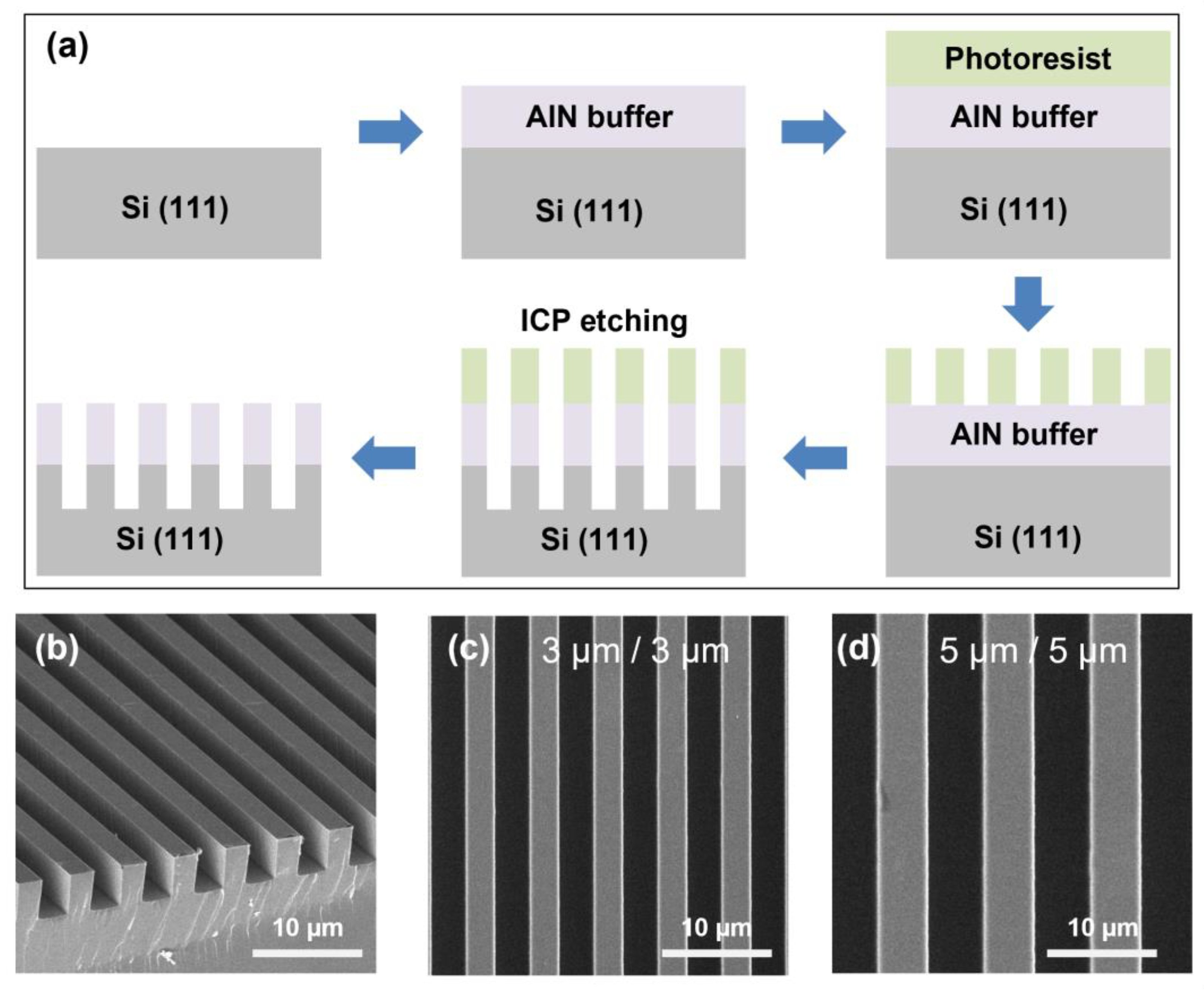
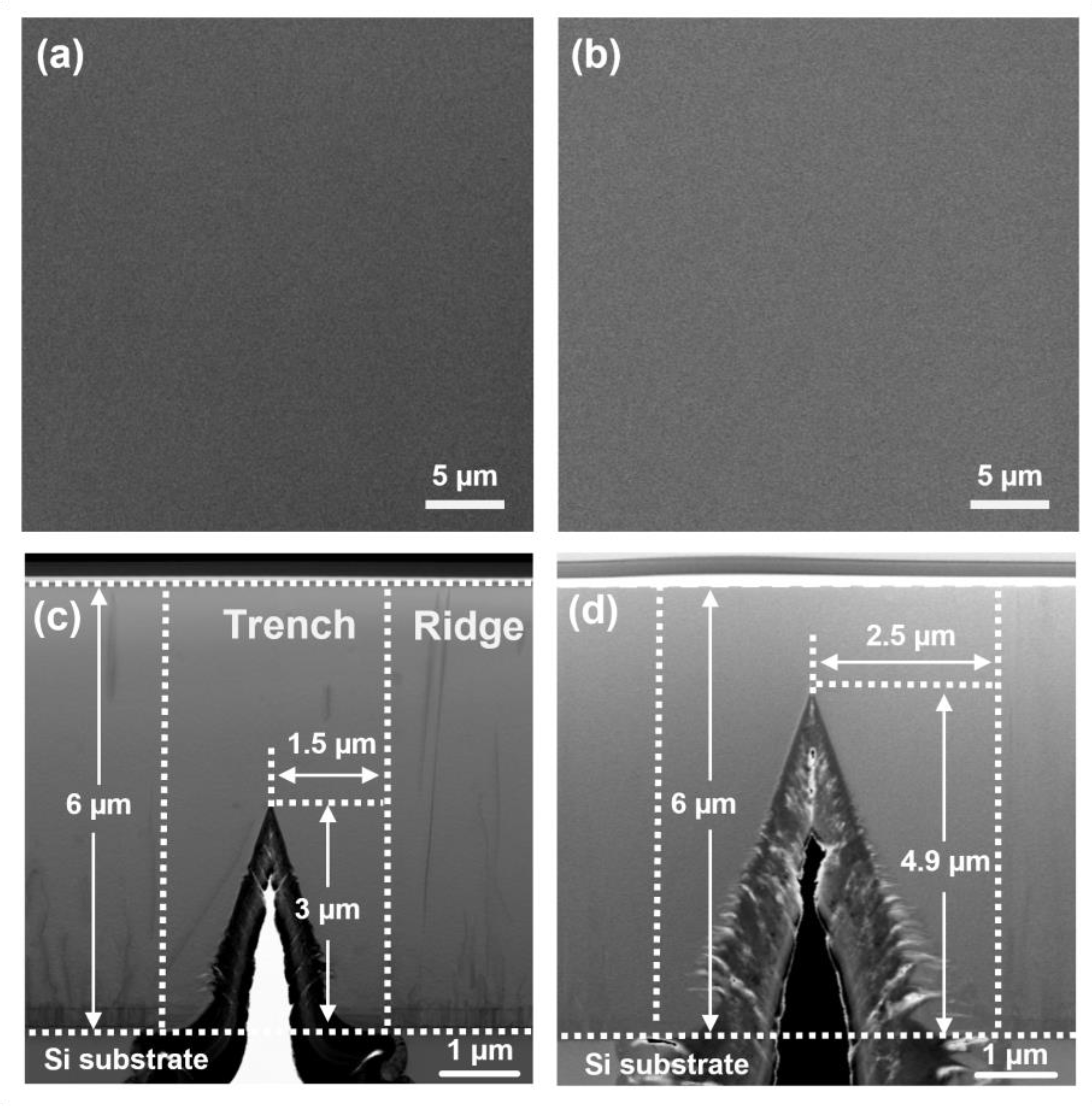
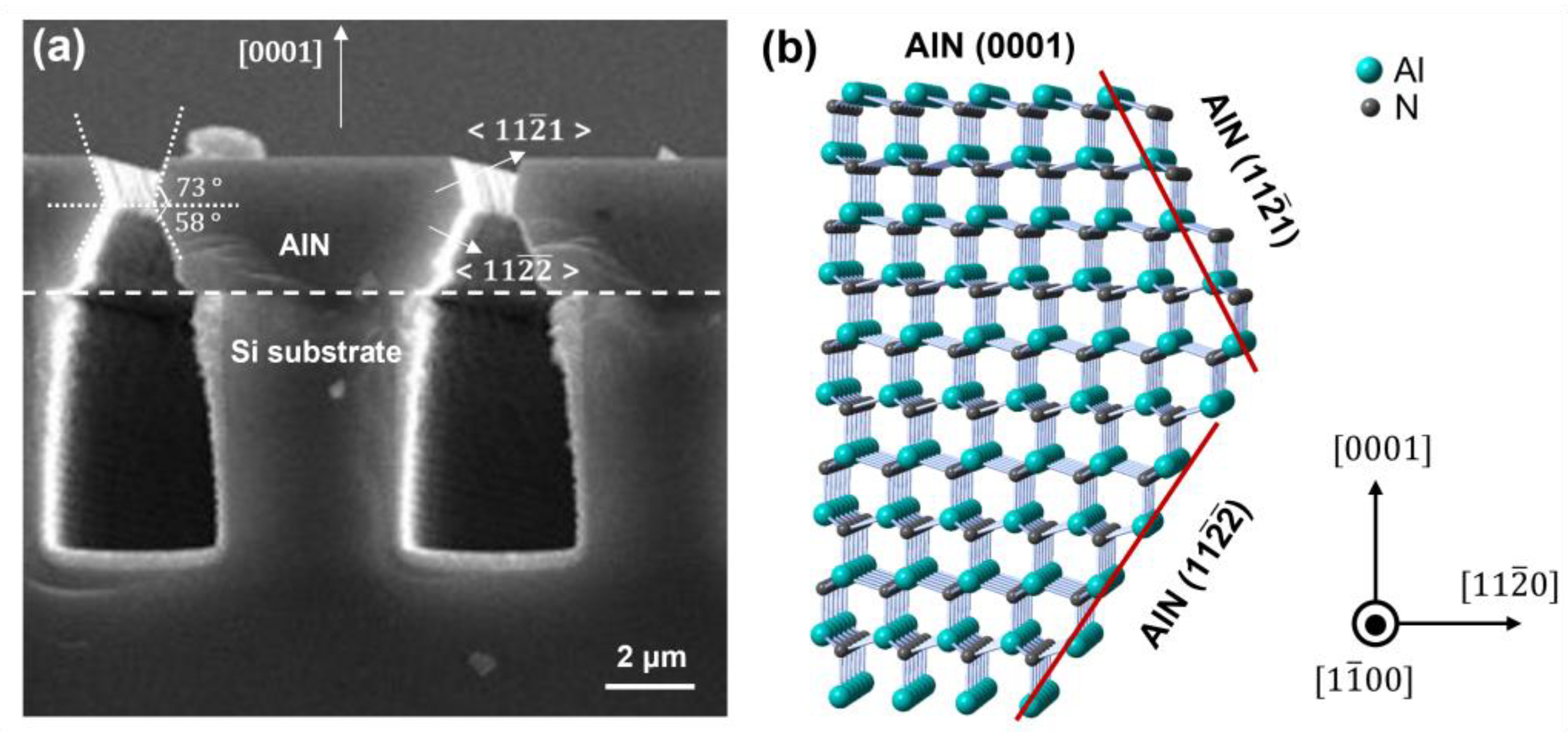
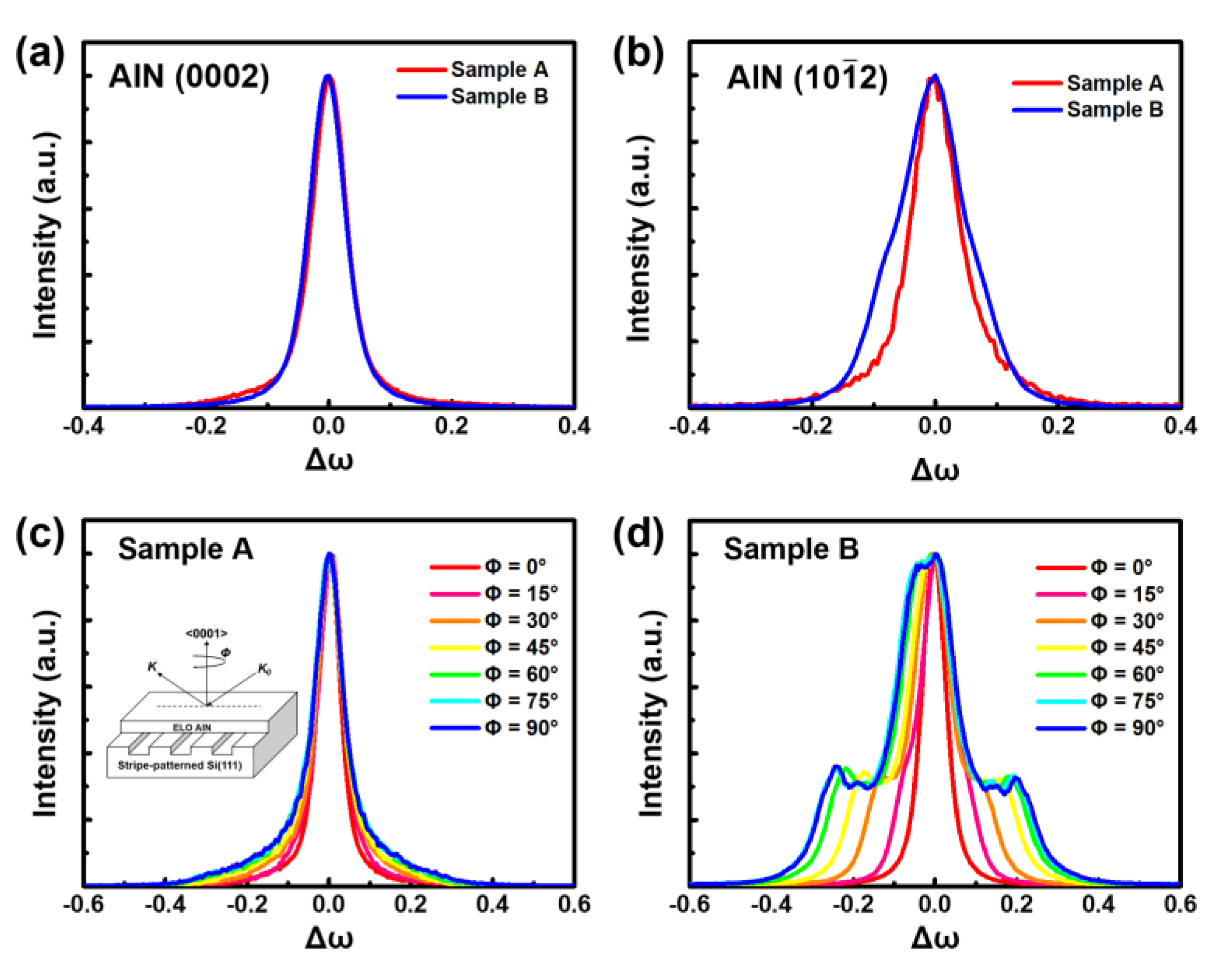
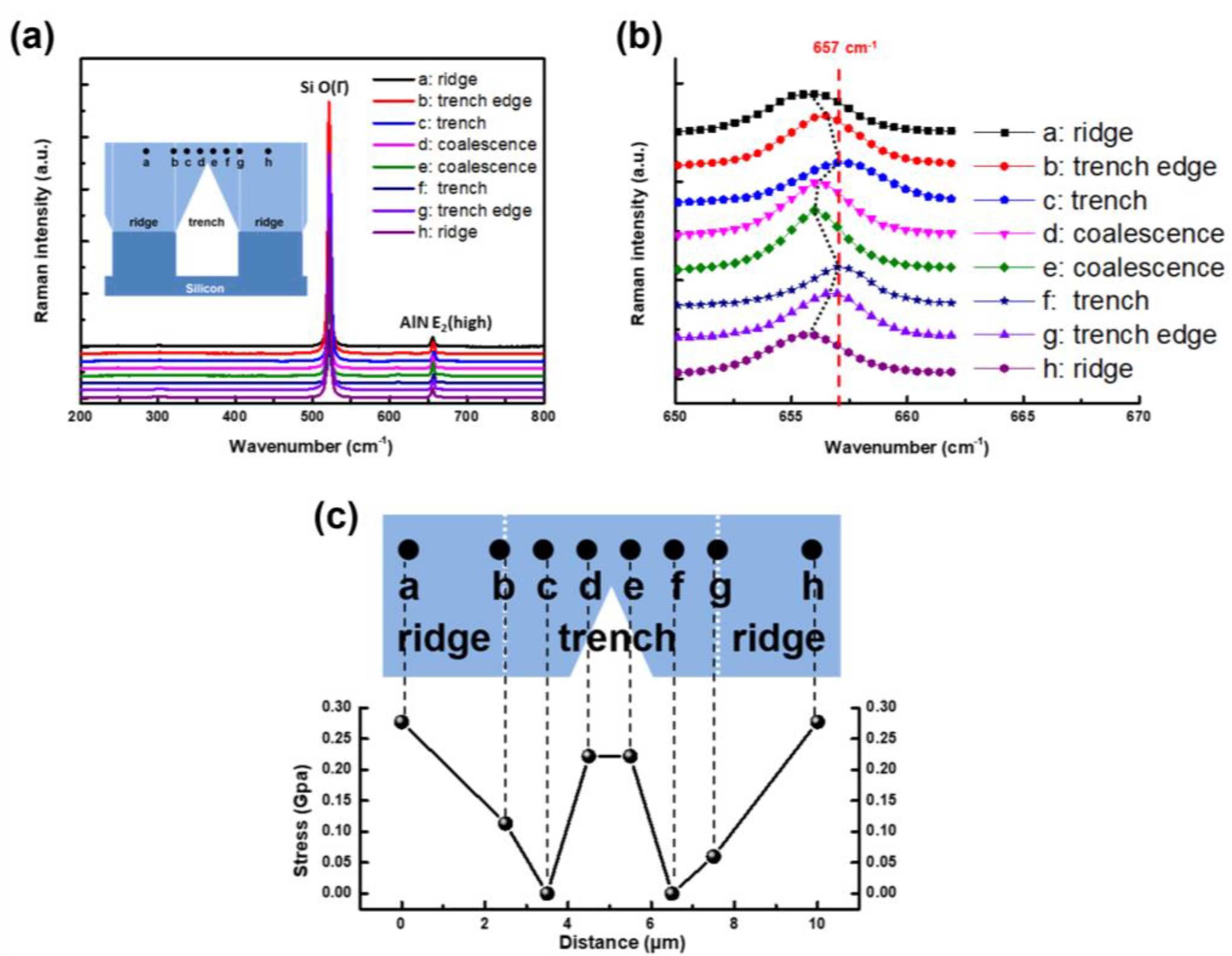

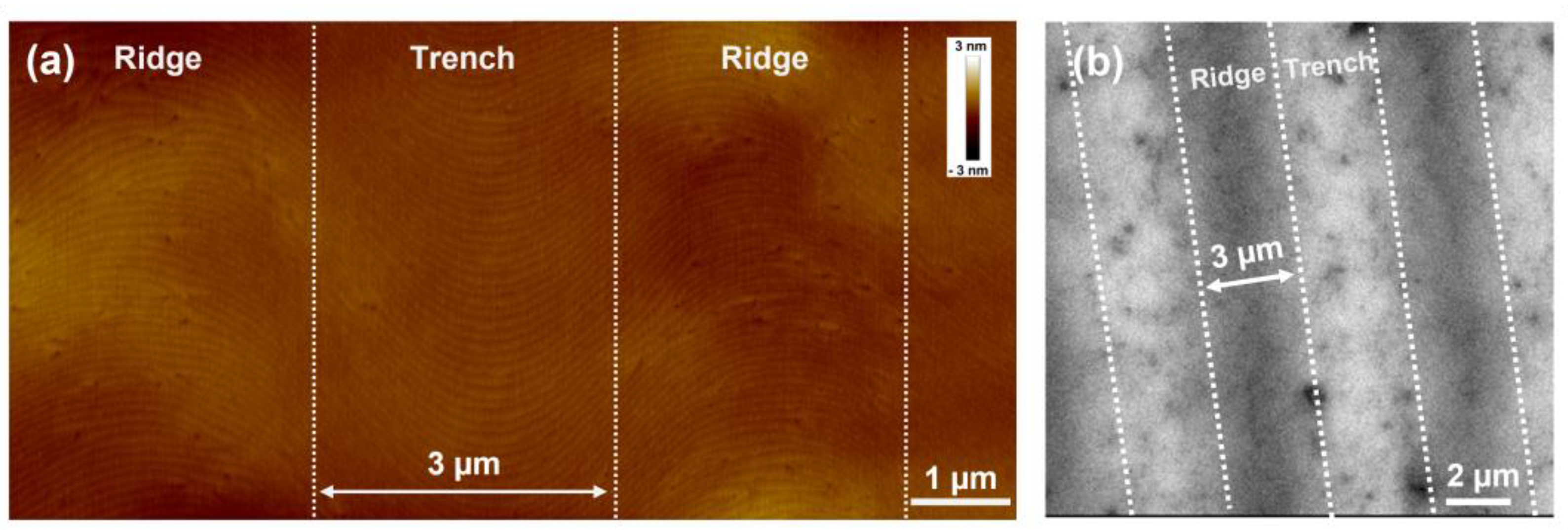
| Group | Substrate Pattern | Thickness (μm) | AlN (0002) (Arcsec) | AlN (10) (Arcsec) |
|---|---|---|---|---|
| Mino et al. [23] | micro-stripe | 4.3 | 780 | 980 |
| Zhang et.al [26] | micro-stripe | 7 | 920 | 780 |
| Tran et.al [27] | micro-circle | 8 | 620 | 1141 |
| Demir et.al [28] | nano-stripe | 2 | 710 | 930 |
| Robin et.al [30] | micro-stripe | 6 | 553 | 768 |
| Shen et.al [31] | nano-circle | 2 | 409 | 677 |
| This work | micro-stripe | 6 | 260 | 374 |
Disclaimer/Publisher’s Note: The statements, opinions and data contained in all publications are solely those of the individual author(s) and contributor(s) and not of MDPI and/or the editor(s). MDPI and/or the editor(s) disclaim responsibility for any injury to people or property resulting from any ideas, methods, instructions or products referred to in the content. |
© 2023 by the authors. Licensee MDPI, Basel, Switzerland. This article is an open access article distributed under the terms and conditions of the Creative Commons Attribution (CC BY) license (https://creativecommons.org/licenses/by/4.0/).
Share and Cite
Huang, Y.; Liu, J.; Sun, X.; Zhan, X.; Sun, Q.; Gao, H.; Feng, M.; Zhou, Y.; Yang, H. High-Quality AlN Grown on Si(111) Substrate by Epitaxial Lateral Overgrowth. Crystals 2023, 13, 454. https://doi.org/10.3390/cryst13030454
Huang Y, Liu J, Sun X, Zhan X, Sun Q, Gao H, Feng M, Zhou Y, Yang H. High-Quality AlN Grown on Si(111) Substrate by Epitaxial Lateral Overgrowth. Crystals. 2023; 13(3):454. https://doi.org/10.3390/cryst13030454
Chicago/Turabian StyleHuang, Yingnan, Jianxun Liu, Xiujian Sun, Xiaoning Zhan, Qian Sun, Hongwei Gao, Meixin Feng, Yu Zhou, and Hui Yang. 2023. "High-Quality AlN Grown on Si(111) Substrate by Epitaxial Lateral Overgrowth" Crystals 13, no. 3: 454. https://doi.org/10.3390/cryst13030454
APA StyleHuang, Y., Liu, J., Sun, X., Zhan, X., Sun, Q., Gao, H., Feng, M., Zhou, Y., & Yang, H. (2023). High-Quality AlN Grown on Si(111) Substrate by Epitaxial Lateral Overgrowth. Crystals, 13(3), 454. https://doi.org/10.3390/cryst13030454







